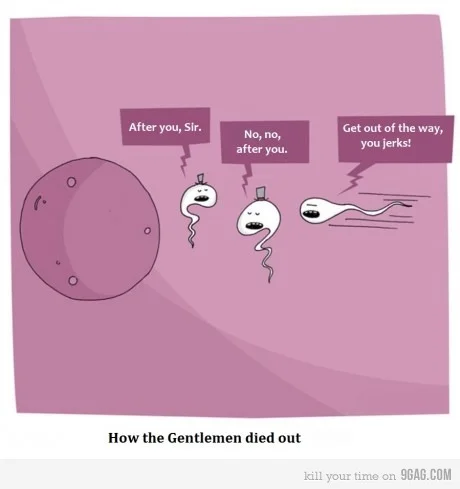From the legendary Laurie Anderson:
Sperm
Sperm bike
Photo: Courtesy of European Sperm Bank
From Treehugger:
The 'Sperm Bike' Carries Donor Samples to Fertility Clinics Around CopenhagenThe Custom-Made 'Sperm Bullitt': Making a Special Delivery...
Copenhagen is a paradise for cyclists and a city that the rest of the world couldlearn a lot from. One of the things that make biking so convenient there is the use of cargo bikes (I wish they were more popular in North-America). As you can see above and below, there are all kinds! This one is the 'Sperm Bullitt' and it belongs to the Nordisk Cryobank (European Sperm Bank).
The 'sperm bike' is used to carry donor samples to fertility clinics around Copenhagen in an environmentally-friendly way, and it also serves as an attention-grabbing advertisement for the sperm bank.
As you can see above, the samples are carried inside the head of the giant sperm. A cooler compartment was especially designed to carry and keep cool the sperm bank's metal canisters.
Read the rest and see more photos here.
Food's effect on flavour of semen.
Gentlemen.
Cautionary tale: swallow.
From Datingish:
Like many men, Dr. Richard O. Phillips was surprised to receive a paternity lawsuit from Dr. Sharon Irons, a former lover, two years after having shared the pleasures of oral sex. Confused, he went for the tried-and-true DNA test, which revealed that he was in fact the father of the child, except it was delivered with sub-Maury Povich charisma and significantly less fanfare.
"How could this be?" he thought to himself, as any rational man would. As it turns out, Dr. Irons had preserved Dr. Phillips' sperm and used it to impregnate herself; an act so creepy and vile that even some of the world's masters of prolific breeding had to shake their furry little heads (rabbits, for the uninformed). But a simple question stood erect: Was she legally entitled to the sperm?
Read the rest of the article here.
Sperm shouldn't use cell phones.
Many have voiced concern about the effects that electromagnetic radiation, emitted by cell phones, may have on cell phone users. A substantial amount of research has been devoted to studying these effects, which appear to quite real (e.g., it is now recommended that cell phone use be limited for children). Some of those studies have examined the effects of cell phone use on sperm. It appears that cell phone use has an adverse effect on sperm:
Gutschi, T., Mohamad Al-Ali, B., Shamloul, R., Pummer, K. and Trummer, H. (2011), Impact of cell phone use on men’s semen parameters. Andrologia, 43(5), 312–316.
The objective of the present retrospective study was to report our experience concerning the effects of cell phone usage on semen parameters. We examined 2110 men attending our infertility clinic from 1993 to October 2007. Semen analysis was performed in all patients. Serum free testosterone (T), follicle stimulating hormone (FSH), luteinising hormone (LH) and prolactin (PRL) were collected from all patients. The information on cell phone use of the patients was recorded and the subjects were divided into two groups according to their cell phone use: group A: cell phone use (n = 991); group B: no use (n = 1119). Significant difference was observed in sperm morphology between the two groups. In the patients of group A, 68.0% of the spermatozoa featured a pathological morphology compared to only 58.1% in the subjects of group B. Patients with cell phone usage showed significantly higher T and lower LH levels than those who did not use cell phone. No significant difference between the two groups was observed regarding FSH and PRL values. Our results showed that cell phone use negatively affects sperm quality in men. Further studies with a careful design are needed to determine the effect of cell phone use on male fertility.
La Vignera, S., Condorelli,R., Vicari, E., D'Agata, R., and Calogero, A. (2011). Effects of the exposure to mobile phones on male reproduction: A review of the literature. Journal of Andrology, DOI:10.2164/jandrol.111.014373.
The use of mobile phones is now widespread. A great debate is going on about the possible damage that the radiofrequency electromagnetic radiation (RF-EMR) emitted by mobile phones exerts on different organs and apparatuses. Aim of this article was to review the existing literature exploring the effects of RF-EMR on the male reproductive function in experimental animals and human beings. Studies on the experimental animals have been conducted in rats, mice, and rabbits using a similar design based upon mobile phone radiofrequency exposure for a variable length of time. Altogether the results of these studies show that RF-EMR decreases sperm count and motility, and increases the oxidative stress. In human beings, two different experimental approaches have been followed, one has explored the effects of RF-EMR directly on spermatozoa and the other has evaluated the sperm parameters in men using or not mobile phones. The results show that human spermatozoa exposed to RF-EMR have decreased motility, morphometric abnormalities, and increased oxidative stress, whereas men using mobile phones have decreased sperm concentration, motility (particularly the rapid progressive one), normal morphology, and viability. These abnormalities seem to be directly related with the length of mobile phone use.
Every Sperm is Sacred.
Killer sperm.
According to the killer (or kamikaze) sperm theory, men produce specialized sperm that will seek out and destroy competitor's sperm. So, if a woman has had sex with more than one men, killer sperm from each suitor will try to take out as many of his competitors' viable sperm, thus increasing the odds of him being the one who gets her pregnant.
Now, research has addressed this hypothesis:
No evidence for killer sperm or other selective interactions between human spermatozoa in ejaculates of different males in vitro Moore, H.D.M., Martin, M. and Birkhead, T.R. (1999)
This study examines one of the possible mechanisms of sperm competition, i.e. the kamikaze sperm hypothesis. This hypothesis states that sperm from different males interact to incapacitate each other in a variety of ways. We used ejaculates from human donors to compare mixes of semen in vitro from the same or different males. We measured the following parameters: (i) the degree of sperm aggregation, velocity and proportion of morphologically normal sperm after 1 and 3 h incubation in undiluted semen samples, (ii) the proportion of viable sperm plus the same parameters as in (i) in 'swim-up' sperm suspensions after 1 and 3 h incubation, (iii) the degree of self and non-self sperm aggregation using fluorescent dyes to distinguish the sperm of different males, and (iv) the extent of sperm capacitation and acrosome-reacted sperm in mixtures of sperm from the same and different males. We observed very few significant changes in sperm aggregation or performance in mixtures of sperm from different males compared with mixtures from the same male and none that were consistent with previously reported findings. The incapacitation of rival sperm therefore seems an unlikely mechanism of sperm competition in humans.
Download the paper here.




